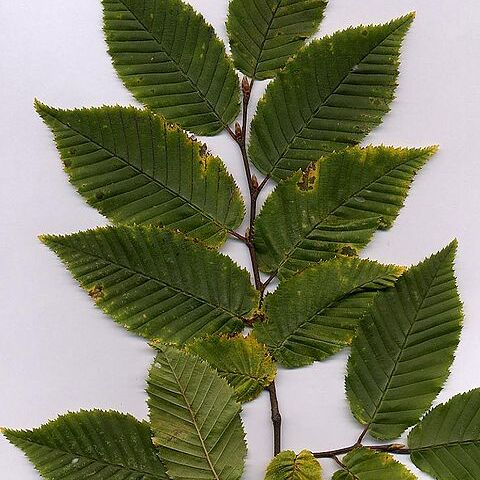Trees , 8--25 m; trunks usually 1, branching mostly deliquescent, trunk and branches irregularly longitudinally ridged, fluted. Bark of trunk and branches bluish to brownish gray, thin, smooth, close [thicker, broken or shredded]; lenticels generally inconspicuous. Wood nearly white to light brown, very hard and heavy, texture fine. Branches, branchlets, and twigs conspicuously 2-ranked; young twigs differentiated into long and short shoots. Winter buds sessile, ovoid, 4-angled in cross section, apex acute; scales many, imbricate, smooth. Leaves on long and short shoots, 2-ranked. Leaf blade narrowly ovate to ovate, elliptic, or obovate with 10 or more pairs of lateral veins, 3--12 × 3--6 cm, thin, margins doubly serrate to serrulate; surfaces abaxially glabrous to tomentose, sometimes covered with small glands. Inflorescences: staminate catkins solitary or in small racemose clusters, lateral, formed previous growing season and enclosed [exposed] in buds during winter, expanding with leaves; pistillate catkins distal to staminate on short, leafy new growth, solitary, ± erect, elongate; bracts and flowers uncrowded. Staminate flowers in catkins 3 per scale, crowded together on pilose receptacle; stamens 3(--6), short; filaments often distinct part way to base; anthers divided into 2 parts, each 1-locular, apex pilose, Pistillate flowers 2 per bract. Infructescences loose racemose clusters of paired bracts, clusters pendulous, elongate; paired bracts deciduous with fruit, expanded, (1--)3-lobed, variously toothed, foliaceous, each bract subtending 1 fruit. Fruits small nutlets, deltoid, longitudinally ribbed, often crowned with persistent sepals and styles. x = 8.
More
Trees, sometimes shrubs, deciduous; bark fissured or smooth. Stipules deciduous. Leaves alternate, irregularly and doubly or simply serrate. Male inflorescence pendulous, spicate-cymose, cylindric, enclosed by buds during winter, with many overlapping bracts; flowers without bracteoles or perianth; stamens 3-12, inserted at base of bracts; filaments forked at apex; anthers 2-loculed, thecae separate, pubescent at apex. Female inflorescence terminal or axillary on dwarf shoots, racemose; flowers paired; bracts leaflike, complanate, overlapping, 2-or 3-lobed at base. Nutlet ribbed, enclosed by lobes of bracts or not.
Staminate catkins pendulous, the scales ovate, each bearing a single naked fl composed of several stamens; filaments short, each divided at the summit and bearing2 apically pilose half-anthers; pistillate catkins slender, somewhat shorter, with ovate, deciduous scales; pistillate fls in pairs, each subtended by a minute bract adnate at base to 2 minute bractlets, the cal also minute; bracts and bractlets accrescent in fr; fr a small, ribbed nutlet; trees or shrubs, fl in early spring. 30, N. Temp.

